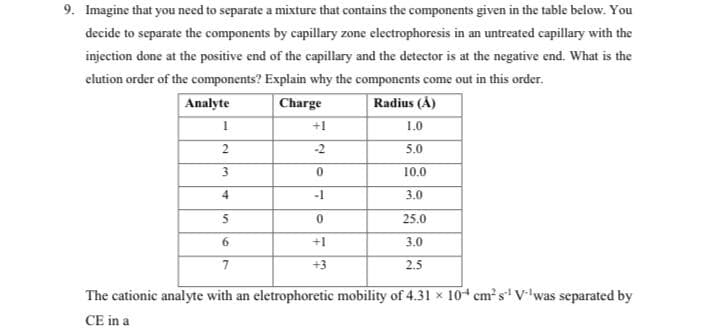9. Imagine that you need to separate a mixture that contains the components given in the table below. You decide to separate the components by capillary zone electrophoresis in an untreated capillary with the injection done at the positive end of the capillary and the detector is at the negative end. What is the elution order of the components? Explain why the components come out in this order. Analyte Charge Radius (A) 1 2 3 4 5 6 7 +1 -2 0 -1 0 +1 +3 1.0 5.0 10.0 3.0 25.0 3.0 2.5 The cationic analyte with an eletrophoretic mobility of 4.31 x 10 cm² s¹ V¹was separated by CE in
9. Imagine that you need to separate a mixture that contains the components given in the table below. You decide to separate the components by capillary zone electrophoresis in an untreated capillary with the injection done at the positive end of the capillary and the detector is at the negative end. What is the elution order of the components? Explain why the components come out in this order. Analyte Charge Radius (A) 1 2 3 4 5 6 7 +1 -2 0 -1 0 +1 +3 1.0 5.0 10.0 3.0 25.0 3.0 2.5 The cationic analyte with an eletrophoretic mobility of 4.31 x 10 cm² s¹ V¹was separated by CE in
Chapter89: Thin-layer Chromatography
Section: Chapter Questions
Problem 4P
Related questions
Question

Transcribed Image Text:9. Imagine that you need to separate a mixture that contains the components given in the table below. You
decide to separate the components by capillary zone electrophoresis in an untreated capillary with the
injection done at the positive end of the capillary and the detector is at the negative end. What is the
elution order of the components? Explain why the components come out in this order.
Analyte
Charge
Radius (A)
1
2
3
4
5
6
7
+1
-2
0
-1
0
+1
+3
1.0
5.0
10.0
3.0
25.0
3.0
2.5
The cationic analyte with an eletrophoretic mobility of 4.31 x 10 cm²s¹ V¹was separated by
CE in a
Expert Solution
This question has been solved!
Explore an expertly crafted, step-by-step solution for a thorough understanding of key concepts.
Step by step
Solved in 2 steps

Knowledge Booster
Learn more about
Need a deep-dive on the concept behind this application? Look no further. Learn more about this topic, chemistry and related others by exploring similar questions and additional content below.Recommended textbooks for you

EBK A SMALL SCALE APPROACH TO ORGANIC L
Chemistry
ISBN:
9781305446021
Author:
Lampman
Publisher:
CENGAGE LEARNING - CONSIGNMENT

Principles of Instrumental Analysis
Chemistry
ISBN:
9781305577213
Author:
Douglas A. Skoog, F. James Holler, Stanley R. Crouch
Publisher:
Cengage Learning


EBK A SMALL SCALE APPROACH TO ORGANIC L
Chemistry
ISBN:
9781305446021
Author:
Lampman
Publisher:
CENGAGE LEARNING - CONSIGNMENT

Principles of Instrumental Analysis
Chemistry
ISBN:
9781305577213
Author:
Douglas A. Skoog, F. James Holler, Stanley R. Crouch
Publisher:
Cengage Learning
